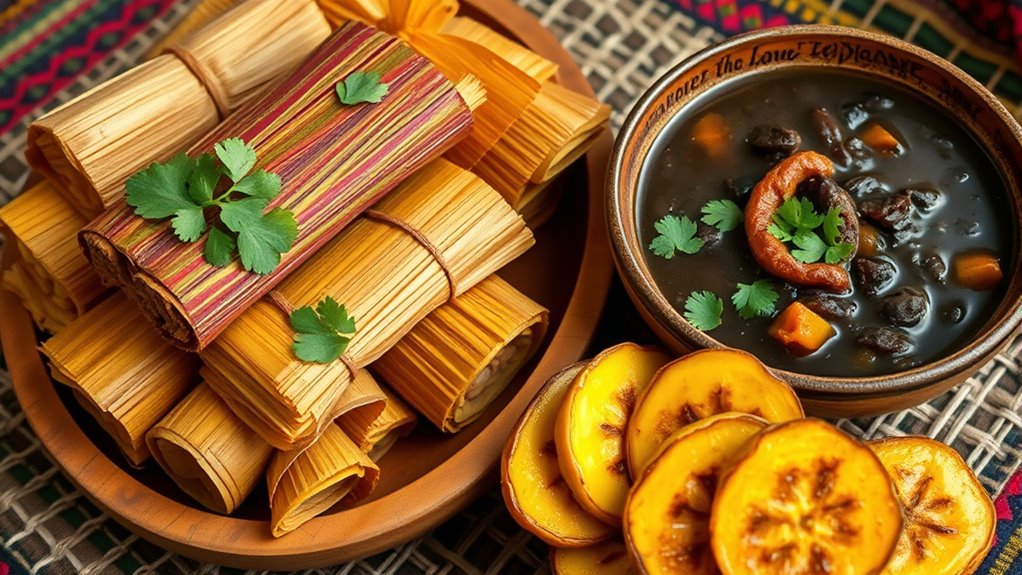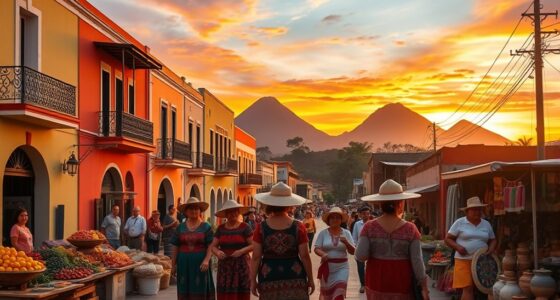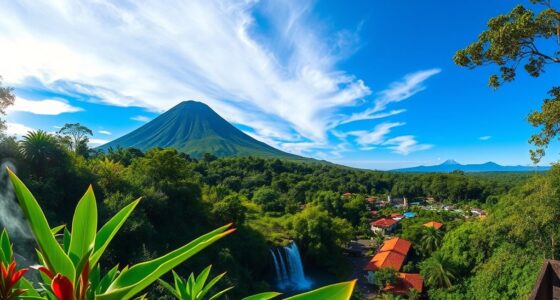Central American cuisine blends indigenous ingredients like corn, beans, and plantains with colonial influences, creating vibrant dishes such as pupusas, pepián, and tamales. You’ll find traditional cooking techniques like grilling, boiling, and fermenting that preserve authentic flavors. Celebratory foods and street eats play a big role in cultural gatherings, showcasing regional diversity. To discover more about this rich culinary heritage, explore the fascinating food traditions that continue to shape Central America today.
Key Takeaways
- Central American cuisine is centered around maize, beans, root vegetables, and diverse meats, reflecting indigenous and colonial influences.
- Signature dishes include pupusas, pepián, nacatamales, and rice-based stews, often served during festivals and celebrations.
- Traditional cooking techniques involve grilling on comals, boiling, frying, and fermenting, preserving cultural authenticity.
- Regional variations incorporate indigenous ingredients, colonial spices, and African influences, creating a rich culinary diversity.
- Street food and vibrant food presentations, including salsas and pickled vegetables, play a vital role in daily life and cultural traditions.
Staples and Key Ingredients in Central American Cooking

Central American cooking revolves around a few core ingredients that define the region’s flavorful and diverse cuisine. You’ll find that corn is the foundation, used in tortillas, tamales, and drinks like atole. Beans, whether black or red, provide essential protein and are often paired with rice, forming a staple carbohydrate combo. Root vegetables like cassava, plantains, and potatoes add variety and texture, frequently fried or boiled. Meat, poultry, and seafood—such as pork, chicken, shrimp, and fish—reflect the region’s geographical diversity and are prepared grilled, stewed, or fried. Spices like chili peppers, garlic, onions, and cilantro enrich dishes with complex flavors. These ingredients are the backbone of Central American cuisine, shaping meals that are hearty, vibrant, and deeply rooted in tradition. Understanding regional ingredients helps to appreciate the rich culinary heritage of Central America.
Signature Dishes From the Region
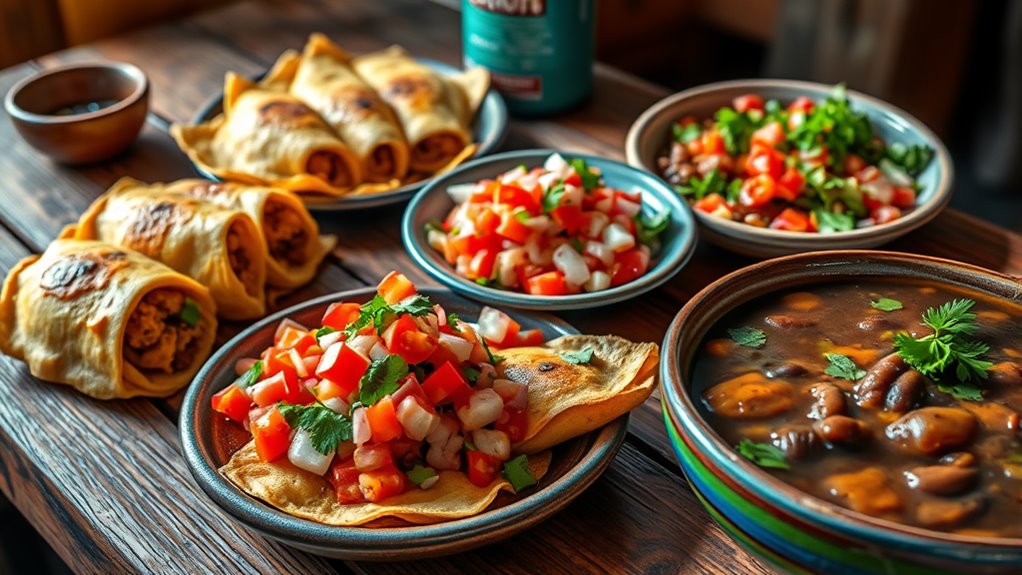
The region boasts a variety of iconic dishes that showcase its rich culinary heritage. These signature dishes reflect indigenous roots combined with Spanish and African influences, offering vibrant flavors and unique techniques. You’ll find hearty stews, flavorful street foods, and traditional staples that define Central American cuisine. Innovative food presentation techniques also enhance the visual appeal of these dishes, making them as attractive as they are delicious.
Discover Central America’s rich culinary heritage through vibrant, hearty dishes blending indigenous, Spanish, and African influences.
Here are some standout dishes:
- Pupusas (El Salvador): Thick corn tortillas stuffed with cheese, beans, or pork, served with curtido and salsa.
- Pepián (Guatemala): A thick, spiced meat stew made with chicken, pork, or beef, along with vegetables and roasted pumpkin seed paste.
- Casado (Costa Rica): A balanced plate of rice, beans, meat, plantains, and fresh salad.
These dishes highlight the region’s diverse ingredients and culinary creativity.
Traditional Cooking Techniques and Food Preparation Methods

Traditional Central American cooking techniques reflect a harmonious blend of indigenous practices and Spanish influences, emphasizing simplicity and flavor. You’ll find that preparing tortillas on a comal—a flat griddle—is fundamental, shaping many dishes like pupusas and tamales. Boiling is common for vegetables, beans, and tamales, preserving natural flavors. Frying, especially with plantains, cassava, and chicharrones, adds texture and richness. Slow cooking stews such as pepián or Indio Viejo allows flavors to meld deeply. You’ll also use fermentation, like in curtido, to add tang and complexity. Wrapping tamales in banana or plantain leaves before steaming or boiling is labor-intensive but essential. These methods highlight resourcefulness and respect for traditional ingredients, creating authentic, flavorful dishes rooted in centuries-old techniques. Incorporating traditional food preparation methods ensures authentic flavors and preserves cultural heritage in Central American cuisine.
Cultural Influences Shaping Central American Cuisine
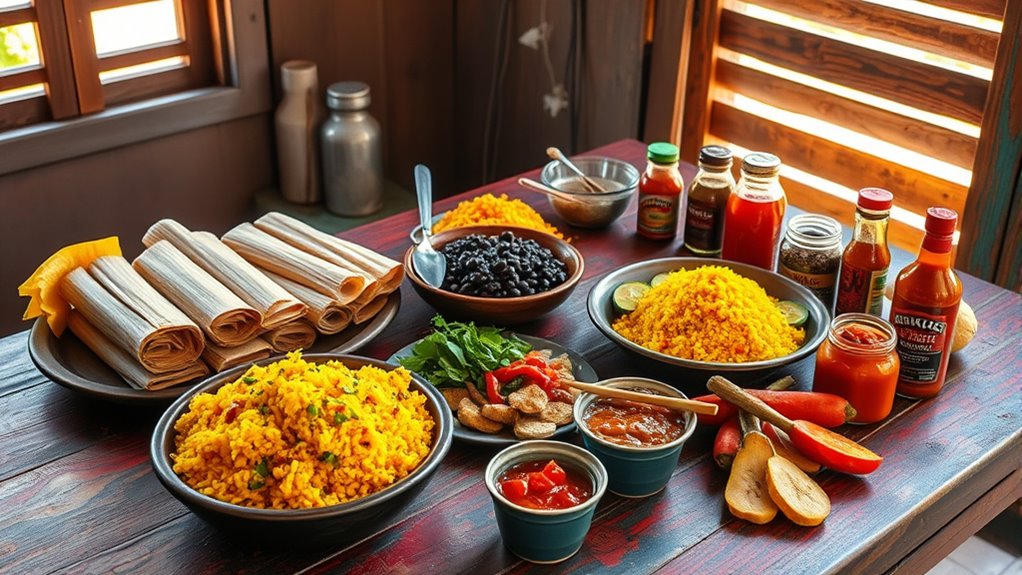
You can see how indigenous heritage shapes Central American cuisine through staple ingredients like corn and local herbs, giving dishes authentic flavors. Colonial influences introduced new meats, spices, and cooking techniques that blend seamlessly with traditional practices. External cultures, such as African and other regional influences, also add unique elements, creating a rich and diverse culinary landscape. Additionally, cultural exchange has played a significant role in continuously evolving the region’s food traditions.
Indigenous Heritage and Flavors
Indigenous cultures have profoundly shaped Central American cuisine, embedding their flavors, ingredients, and cooking techniques into everyday meals. You’ll notice the deep roots of Mayan, Pipil, and other native traditions in the use of corn, herbs, and cooking methods. Their influence is evident in iconic dishes like tamales, pupusas, and tortillas, which rely on maize as the foundation. Indigenous techniques such as grilling on a comal and fermenting vegetables with curtido are still essential today. Their rich knowledge of local ingredients and flavor combinations creates a vibrant culinary landscape. Additionally, traditional cooking methods continue to be passed down through generations, preserving the authenticity of regional flavors.
Colonial and External Influences
Colonial powers, especially Spain, substantially reshaped Central American cuisine by introducing ingredients, cooking techniques, and dishes that blended with indigenous practices. Spanish colonizers brought wheat flour, dairy products, and meats like pork and beef, which integrated into local recipes. They introduced new cooking methods such as frying and baking, alongside spices like cumin and oregano, enriching traditional flavors. The Spanish also introduced dishes like tamales wrapped in banana leaves, and beverages like horchata and atole, blending native ingredients with European techniques. Additionally, these influences led to the development of fusion dishes that combine indigenous and European culinary elements. The Spanish also introduced dishes like tamales wrapped in banana leaves, and beverages like horchata and atole, blending native ingredients with European techniques. African influences arrived through the coast, contributing seafood recipes, coconut milk, and spices. These external influences merged with indigenous traditions, creating a dynamic culinary landscape characterized by diverse ingredients, techniques, and flavors that define modern Central American cuisine.
The Role of Corn, Beans, and Plantains in Daily Meals
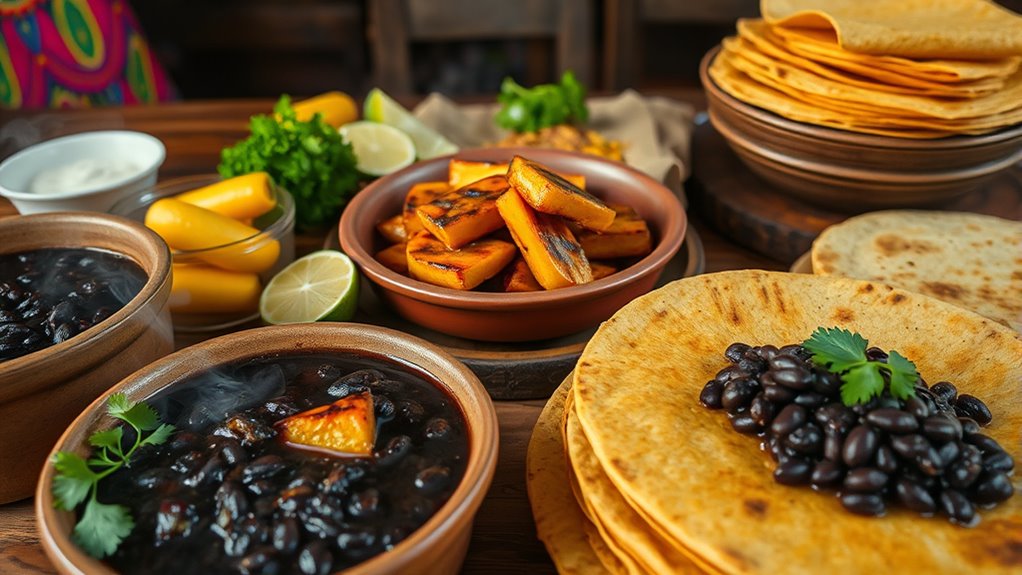
Corn, beans, and plantains form the backbone of daily meals across Central America, providing essential nutrients and flavor. You’ll find these ingredients in countless traditional dishes, from tortillas and tamales to fried plantains and hearty stews. They’re versatile, filling, and deeply rooted in local culture. These staples aren’t just food; they symbolize regional identity and history. Incorporating them into your meals offers a taste of authentic Central American cuisine. Here’s what makes them crucial:
Corn, beans, and plantains are vital staples that embody Central American culinary tradition and culture.
- Corn as the foundation for tortillas, pupusas, and drinks like atole
- Beans offering protein and fiber, often paired with rice or used as fillings
- Plantains providing sweetness and texture in fried, boiled, or stewed forms
- Vetted electric bike conversion kits demonstrate the importance of reliable and versatile components in modern transportation, much like these traditional staples are essential in daily life.
Together, they create balanced, flavorful, and nourishing everyday meals.
Common Accompaniments and Typical Meal Structures
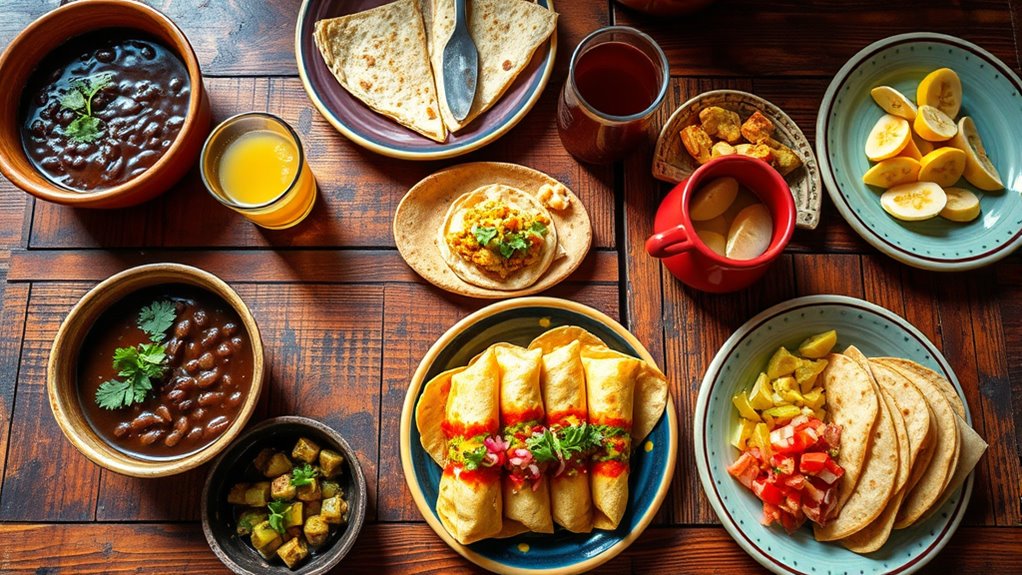
You’ll notice that Central American meals often feature a variety of side dishes like pickled vegetables, salsas, and fresh salads to add flavor and contrast. Typical meal components include a carbohydrate such as rice or tortillas, a protein like meat or seafood, and vegetables to create balanced plates. Street food is also popular, with hearty options like pupusas and baleadas serving as convenient accompaniments for everyday eating.
Traditional Side Dishes
Traditional side dishes play an essential role in Central American meals, often balancing rich, hearty main courses with fresh, tangy, or spicy accompaniments. These dishes enhance flavors and add variety to your plate. Common sides include tangy curtido, a fermented cabbage slaw that pairs with pupusas and tamales. Fresh salsas made from tomatoes, chilies, and herbs provide heat and brightness. You’ll also find plantains—either fried as patacones or ripe and sweet—adding sweetness and crunch. These sides are versatile, often served alongside rice and beans or grilled meats. They bring balance, texture, and flavor, making each meal more satisfying. Whether it’s a smoky salsa, tangy curtido, or fried plantains, these traditional sides deepen your culinary experience across Central America. Additionally, incorporating regional specialties into your meals can enhance authenticity and variety.
Typical Meal Components
Central American meals typically feature a balanced combination of components that create satisfying and flavorful plates. You’ll often find a carbohydrate like rice, tortillas, or tamales paired with protein such as meat, seafood, or beans. Vegetables, including salads, curtido, or cooked greens, add freshness and texture. Accompaniments like salsas, pickled vegetables, and spicy condiments enhance flavor and provide acidity. Street food plays a significant role, with dishes like pupusas, baleadas, and tamales easily accessible and hearty. Beverages like fresh fruit juices, fermented drinks, and coffee complement the meal. The structure usually involves a main carbohydrate, a protein, and flavorful sides, reflecting both indigenous traditions and colonial influences, creating well-rounded, satisfying meals.
Celebratory Foods and Food Traditions Across Countries
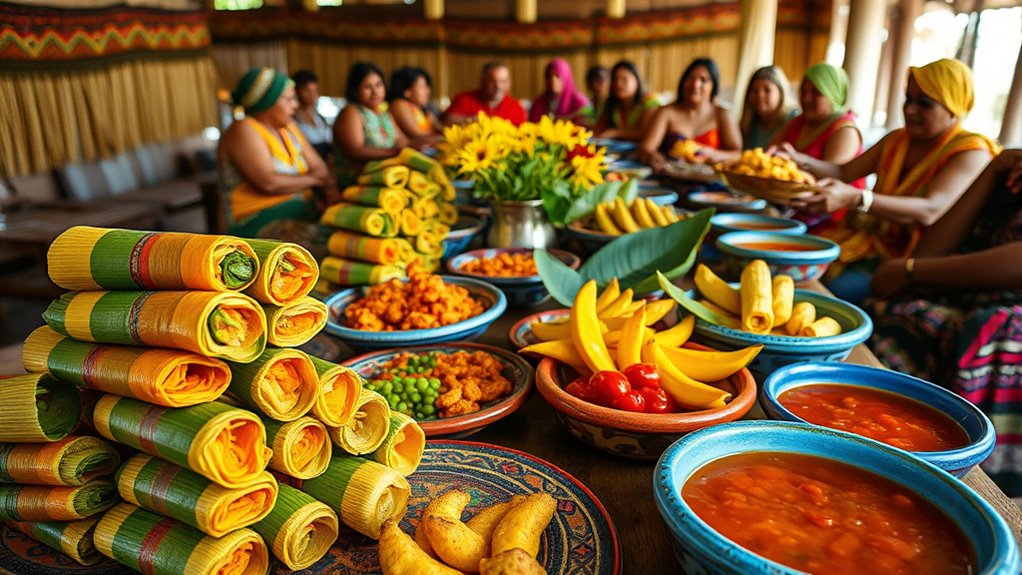
Celebratory foods in Central America play a essential role in marking festivals, religious events, and communal gatherings, reflecting the region’s rich cultural diversity. You’ll find special dishes that symbolize tradition, unity, and local identity during these occasions. In El Salvador, pupusas are a must-have at celebrations, often enjoyed with curtido and salsa. Guatemala’s Pepián, a hearty meat stew, is served during festivals to honor heritage. In Nicaragua, nacatamales are prepared for Christmas and other religious events, showcasing indigenous techniques.
- Pupusas and curtido during local festivals
- Pepián and tamales for religious holidays
- Nacatamales and rice dishes for Christmas and special occasions
Frequently Asked Questions
How Do Indigenous and Spanish Influences Blend Uniquely in Central American Dishes?
You see indigenous and Spanish influences blend in Central American dishes through ingredients and techniques. Indigenous traditions bring maize, beans, and local herbs, while Spanish colonizers introduced meats, dairy, and wheat flour. You’ll notice dishes like pupusas combining maize dough with Spanish-influenced fillings, or stews like Pepián that mix native spices with Spanish herbs. This fusion creates rich flavors, diverse textures, and a unique culinary identity across the region.
What Are the Traditional Methods for Preparing and Preserving Regional Ingredients?
Imagine revealing the secrets of Central American flavors. You’ll find traditional methods like nixtamalization, where corn is soaked and cooked in limewater to enhance nutrition and flavor, transforming it into masa for tortillas and tamales. Fermentation plays a key role, preserving vegetables like curtido and making beverages like chicha. Boiling, grilling, and slow stewing also preserve ingredients, ensuring freshness and depth of taste that reflect centuries of culinary wisdom.
How Do Regional Climates Affect Ingredient Availability and Cuisine Styles?
Your regional climate directly influences ingredient availability and cuisine styles in Central America. In coastal areas, warm, humid weather supports abundant seafood, coconut, and tropical fruits, leading to seafood stews and coconut-based dishes. In highland regions, cooler temperatures favor root vegetables, maize, and hearty stews. You’ll notice that climate shapes what’s fresh and abundant, guiding your cooking choices toward ingredients suited to the environment, creating diverse and region-specific flavors.
What Role Do Street Foods Play in Daily Life and Cultural Identity?
Street foods serve as savory symbols of local life, linking tradition with daily delight. You find bustling markets filled with pupusas, baleadas, and tamales, offering quick, quality bites that connect communities. These foods foster cultural pride, preserve regional flavors, and provide accessible, affordable nourishment. As you sample street snacks, you immerse yourself in the vibrant vibrancy of local life, understanding that these dishes are more than meals—they’re memories, moments, and milestones.
How Are Modern Culinary Trends Integrating With Traditional Recipes?
You see modern culinary trends blending seamlessly with traditional recipes in Central America. Chefs and home cooks incorporate new techniques like sous-vide or fusion ingredients while respecting native flavors. You might find traditional dishes updated with international spices or presented in contemporary styles. This integration preserves cultural identity while appealing to evolving tastes, creating exciting, innovative dishes that honor the region’s rich culinary heritage.
Conclusion
As you explore Central American cuisine, remember that food tells stories of history, culture, and community. From vibrant flavors to traditional techniques, it’s like a tapestry woven with love and legacy. Embrace the saying, “You are what you eat,” and savor each bite as a piece of the region’s rich heritage. Let the warmth of these dishes remind you that good food brings people together, just as the sun unites the land.

